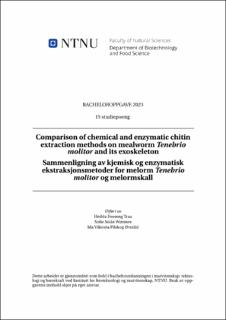Sammenligning av kjemisk og enzymatisk ekstraksjonsmetoder for melorm Tenebrio molitor og melormskall
Bachelor thesis

Permanent lenke
https://hdl.handle.net/11250/3077925Utgivelsesdato
2023Metadata
Vis full innførselSamlinger
Sammendrag
Bakgrunn - Kitin er et polysakkarid som det finnes rikelig av i naturen. Det kan ekstraheres fra melormog brukes i næringsmiddelindustrien.
Mål - Målet for prosjektet var å ekstrahere kitin fra melorm og melormskall ved hjelp av en kjemisk ogen enzymatisk protokoll.
Materialer og metoder - Råstoffet ble analysert med Kjeldahls metode og CHNS. En kjemisk og enenzymatisk prosedyre ble gjennomført for å ekstrahere kitin. CHNS ble brukt for å karakterisere ekstraktene og supernatantene. Det ble og brukt en analyse for amindeteksjon med OPA-reagens for beggeprøvene.
Resultat - Proteininnholdet i melormen ble 59.50% med Kjeldahl og 68.20% med CHNS. I skallet bledet 49.8% med Kjeldahl og 59.70% med CHNS. Kjemisk ekstrahert skallprøve hadde 65.70% protein ogmelormprøven hadde 68.80%. Supernatanten fra kjemisk behandlet skallprøve inneholdt 56.20% protein og supernatanten fra kjemisk behandlet melormprøve inneholdt 59.90% protein. Proteininnholdet for melormprøven fra enzymatisk ekstraksjon ble 55.20%, og 59.60% for kjemisk ekstrahert skallprøve. Supernatanten fra enzymatisk behandlet skallprøve inneholdt 59.30% protein, og tilsvarendebehandlet melormprøve inneholdt 59.40%. Forholdet mellom karbon/nitrogen var 6.24±0.36 i skallprøve fra enzymatisk ekstraksjon, 4.46±0.03 i supernatanten for skallprøve fra enzymatisk ekstraksjon,5.12±0.24 i melormprøve fra enzymatisk ekstraksjon og 4.62±0.16 i supernatanten fra melormprøve fraenzymatisk ekstraksjon. Forholdet mellom karbon/nitrogen var 5.25±0.04 i skallprøven fra kjemsik ektraskjon, 4.91±0.14 for supernatanten fra skallprøven fra kjemisk ektraskjon, 5.50±0.04 i melormprøvenfra kjemisk ekstraksjon og 4.75±0.01 i supernatanten fra kjemisk ekstrahert melormprøve.
Konklusjon - Det var ingen bemerkelsesverdige forandringer i sammensetningen av ekstraktene. Tilstedeværelse av p Background - Chitin is a polysaccharide that can be utilised in the food industry that can be extractedfrom mealworm.
Aim - The aim of the project was to chemically and enzymatically extract chitin from mealworm and itsexoskeleton.
Materials and method - The raw materials were analysed with Kjeldahl method and CHNS. A chemicaland enzymatic protocol was used to extract chitin. CHNS analysis was used to characterise the extractsand the supernatants. Amine detection analysis was also used to characterise the supernatants and theraw materials.
Results - The protein content of the mealworm was calculated to 59.50% with Kjeldahl and 68.20% withCHNS. For the exoskeleton the protein content was calculated to 49.8% with Kjeldahl and 59.70% withCHNS. The protein content from the chemical extraction was calculated to 65.70% for the exoskeletonand 68.80% for the mealworm. In the chemical extraction, the protein content from the supernatantswere 56.20% for the exoskeleton and 59.90% for the mealworm. The protein content from the enzymaticmethod was 59.60% for the exoskeleton and 55.20% for the mealworm. For the supernatants from theenzymatic extraction the protein content was calculated to 59.30% for the exoskeleton and 59.40% forthe mealworm. From the enzymatic extraction, the carbon/nitrogen ratio was 6.24±0.36 for the exoskeleton, 4.46±0.03 for the exoskeleton supernatant, 5.12±0.24 for the mealworm and 4.62±0.16 for themealworm supernatant. For the chemical extracton, the carbon/nitrogen ratio was 5.25±0.04 for theexoskeleton, 4.91±0.14 for the supernatant of exoskeleton, 5.50±0.04 for the mealworm and 4.75±0.01for the mealworm supernatant.
Conclusion - There were no notable differences in the composition of the extracts. The presence ofprotein in the supernatants show that the protein content in the extracts could be lower than the rawmaterials